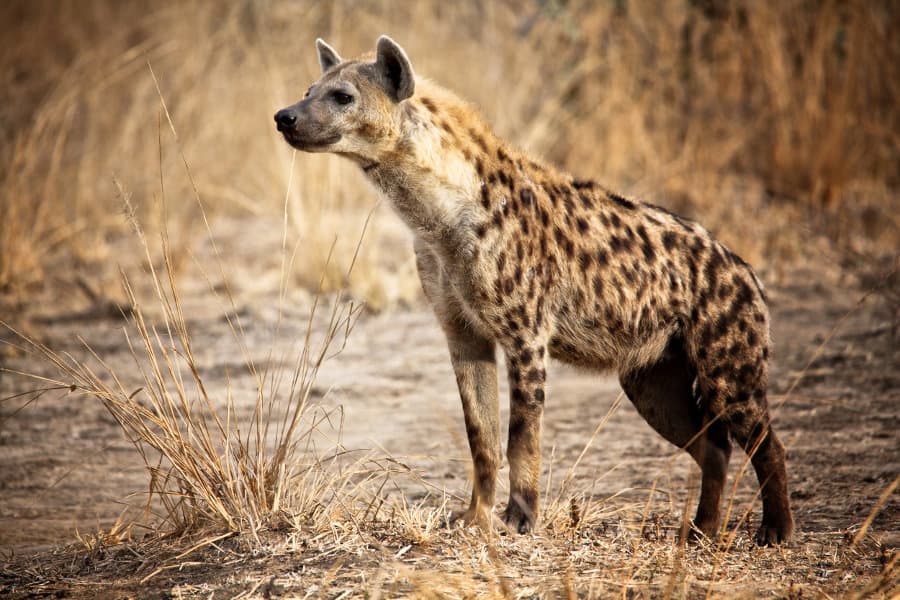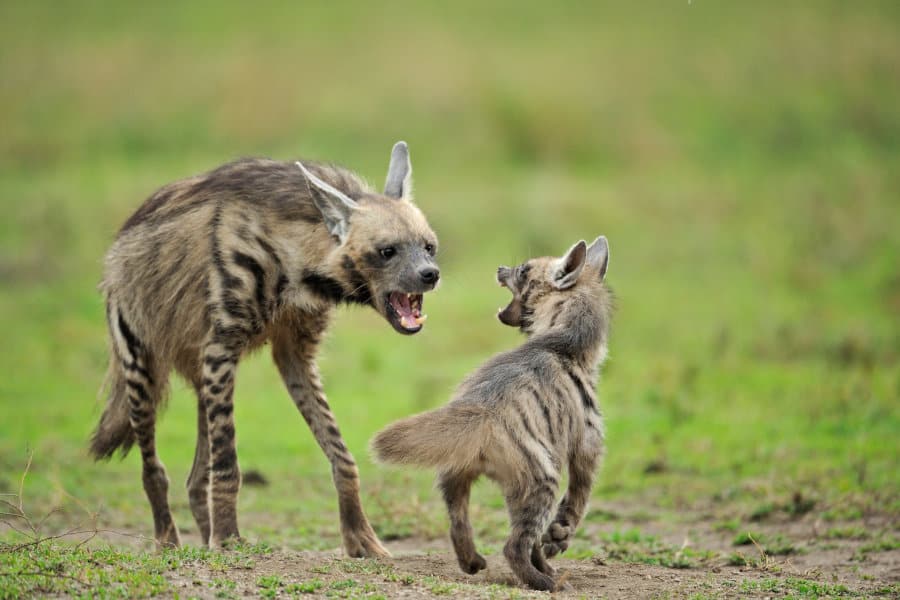Are hyenas just scavengers?
It’s a common misconception of Africa’s most misunderstood mammals. People imagine a sinister creature stealing kills from lions and other predators. A cackling coward skulking in the shadows.
That’s just one species – the spotted hyena. (It’s not an accurate description either, but we’ll get to that later.)
In fact, there are several species of hyena, all with different behaviour and diets. Some scavenge; some hunt – most do both. But why are scavengers vilified in the first place?
The hyena family has an image problem, but if you dig deeper, you’ll find a fascinating group of animals that should be celebrated and respected.
Is the Hyena a Scavenger or a Hunter?

Is the hyena a scavenger or a hunter? Yes.
I’m sure you’re confused, but there’s no single answer to the question. Firstly, let’s figure out which hyena you’re talking about.
The most famous species is undoubtably the spotted hyena. These are the largest, most widespread, and probably the most misunderstood of all hyenas.
Rounding out the hyena family are three other species: striped hyenas, brown hyenas, and the smaller, more distant relative, the aardwolf.
Spotted Hyena – Adept Hunter
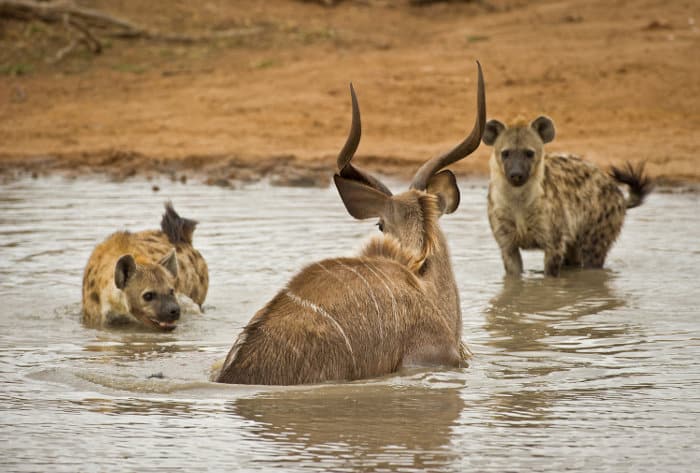
If spotted hyenas know a decent lawyer, they should consider suing Disney for defamation.
It’s not just The Lion King – popular culture reinforces the misconception of spotted hyenas as “mangy scavengers” who gang up on noble predators to steal their meal.
The truth might surprise you. Spotted hyenas are (sometimes) scavengers, but they’re also one of Africa’s best hunters.
The stereotype is a pack, or ‘clan,’ of hyenas stealing a lion’s kill. In reality, the reverse is equally common. Hyenas hunt just as much as their ‘mane’ rivals. (Plus, they’re more successful.)
Spotted hyenas’ favourite prey differs based on location, but favourites include medium-sized ungulates like zebra, antelope, and wildebeest. Despite their reputation as pack hunters, they attempt lone hunts more often – but their success rate is much higher when the clan works together.
Effective scavengers
Spotted hyenas are scavengers too, though. Their powerful jaws are just as effective on carrion as live prey, and their adaptations ensure they don’t waste any food. Even the mightiest herbivores (like elephants) often wind up as a meal for a grateful hyena clan.
Spotted hyenas can both splinter and digest large bones. They don’t mess around at dinner time, and when the whole clan gathers for dinner, they make short work of even the biggest meals.
Striped Hyena – Mysterious, Magical Beast?

Striped hyenas are another misunderstood member of Hyaenidae. Linked to magic and witchcraft in many cultures, this species’ reputation has unjustly suffered.
Striped hyenas are widespread in North and East Africa, the Middle East, and beyond, but while they’re found in many countries, their overall numbers are low. Their body parts are wrongly assumed to have magical properties in many areas; this could explain some of the persecution they face.
They’re not pack hunters like their larger relative, the spotted hyena, and their smaller size means they can’t take down large prey. They’ll sometimes kill their own food if the opportunity arises, though.
Specialist scavengers
Despite the occasional kill, Striped hyenas are mostly scavengers. The best description of their diet is “not fussy.”
Thanks to strong stomach acid, striped hyenas can stomach (literally) all kinds of things we’d turn our nose up at. They’re happy to eat rotten flesh, or root around garbage where they live alongside humans.
Is it glamourous? Not exactly, but scavengers like striped hyenas play an important role in ecosystems. Without them hoovering up carrion, disease could spread to other species.
Brown Hyena – Looks Can Be Deceiving
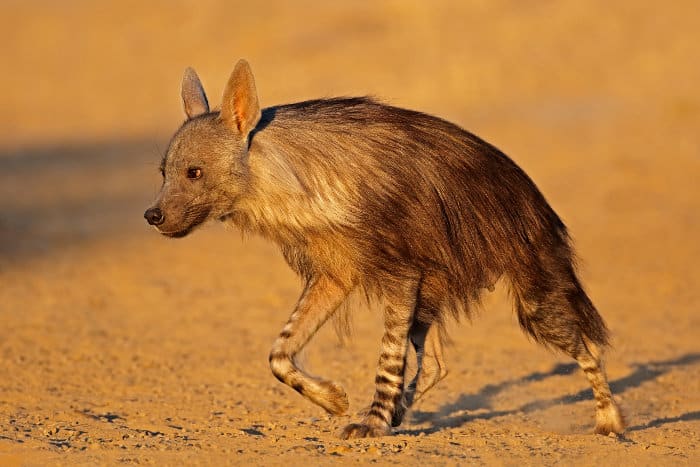
The shaggy-looking strandwolf, or brown hyena, is the rarest of its family. Its population of just 4000 – 10 000 is spread across a handful of countries in Southern Africa.
Like the spotted hyena, brown hyenas are social creatures who live in clans. They’re adaptable, too, and inhabit a diverse range of habitats from grassland to beaches, mountains, and woodland. (Their nickname ‘strandwolf’ translates to ‘beach dog.’)
Are brown hyenas just scavengers? Primarily, yes. They’re poor hunters, but they’ll take easy prey like seal pups and other small mammals.
What they lack in hunting skill they make up for in aggression. Brown hyenas will challenge predators like cheetahs, leopards, and jackals for their kills.
The brown hyena’s bad reputation
Beauty is in the eye of the beholder, but brown hyenas aren’t winning any beauty pageants. Their scruffy, shaggy appearance could be one reason why they aren’t well-regarded by most people.
Another reason is mistaken identity. Farmers will sometimes see brown hyenas scavenging on livestock and wrongly blame them for the killings. Human persecution is the biggest threat to the species’ survival.
Aardwolf – Black Sheep of the Hyena Family
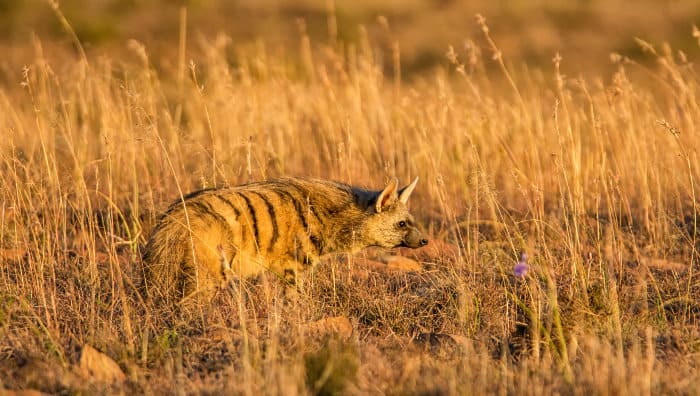
The fourth member of Hyaenidae doesn’t seem much like its relatives. In fact, aardwolves used to be classified in a separate family. Studies have since shown that they share a common ancestor with the other three hyena species.
Hyenas diverged into “dog-like hyenas” and “bone-crushing hyenas” millions of years ago. While the other three species are bone-crushers, aardwolves are the last surviving dog-like species. (Superficially, at least. They’re not canines.)
Insectivorous Hyenas
These differences are reflected in the aardwolf’s diet. Aardwolves lack the powerful jaws for crunching up mammals’ remains; they’ve evolved to specialise on insects instead. Their favourite dish is termites, which they lap up with their long, sticky tongue.
So, aardwolves seem to be the only hyenas who aren’t scavengers.
Are Hyenas Just Scavengers? No.
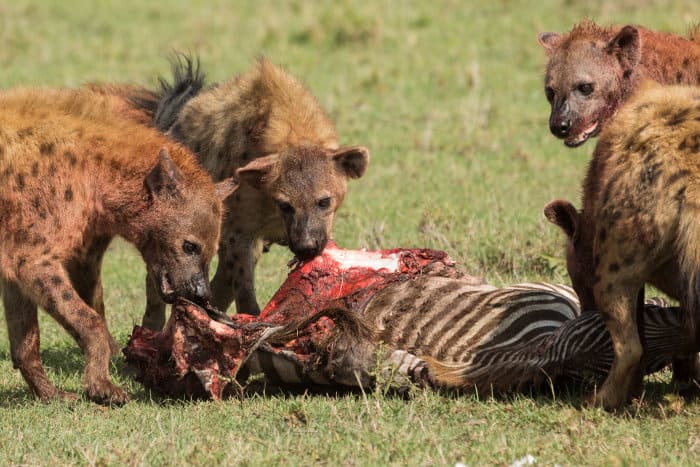
Are hyenas just scavengers? As you’re now aware, the answer is no.
It’s clear that the hyena family is complex, intriguing, and diverse. Most hyena species are scavengers, but only some are primarily scavengers. The versatile family has adapted to fill different niches in many different habitats, holding their own against larger, more renowned predators.
Calling animals like hyenas just scavengers minimises their importance. These creatures have a vital role ‘cleaning up’ carcasses and improving the health of their local ecosystems. Scavengers should be celebrated!
With numbers dwindling, it’s more important than ever to get people to respect hyenas, or they’ll continue to be persecuted. Sure, they may not be the prettiest, but they’re smart, resourceful animals with an undeserved negative reputation.
With more conservation efforts, and attempts to educate people about hyenas, hopefully the only way they’ll be shot is through a camera lens. You’re most likely to see a spotted hyena, but if you’re lucky you might catch a glimpse of one of its rarer relatives.
Book a custom safari to see these special ‘scavengers’ in action.


